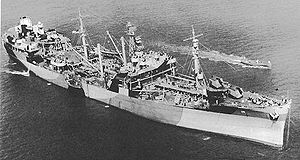USS Salamonie (AO-26)

| |
| Career | |
|---|---|
| Name: | USS Salamonie |
| Builder: | Newport News Shipbuilding and Drydock Company, Newport News, Virginia |
| Laid down: | 5 February 1940 |
| Launched: | 18 September 1940 |
| Sponsored by: | Mrs. Eugene Holman |
| Commissioned: | 28 April 1941 |
| Struck: | 2 September 1969 |
| Fate: | Sold for scrapping, 24 September 1970 |
| General characteristics | |
| Class and type: | Cimarron-class oiler |
| Displacement: |
7,470 long tons (7,590 t) light 24,830 long tons (25,228 t) full load |
| Length: | 553 ft (169 m) |
| Beam: | 75 ft (23 m) |
| Draft: | 32 ft 4 in (9.86 m) |
| Propulsion: |
Twin screws, 30,400 shp (22,669 kW) Steam (600psi), NSFO |
| Speed: | 18 knots (21 mph; 33 km/h) |
| Complement: | 304 |
| Armament: |
• 4 × 5 in (130 mm)/38 cal. guns (4×1) • 4 × 40 mm AA guns • 4 × 20 mm AA guns |
| Service record | |
|---|---|
| Operations: | World War II |
USS Salamonie (AO-26) was a Cimarron-class fleet replenishment oiler, named for the Salamonie River in Indiana.
Salamonie was laid down on 5 February 1940 under a Maritime Commission contract (MC hull 13) as Esso Columbia by the Newport News Shipbuilding and Drydock Company, Newport News, Virginia.; launched on 18 September 1940; sponsored by Mrs. Eugene Holman; designated for US Navy use on 20 November 1940; and commissioned on 28 April 1941, Commander T. M. Waldschmidt in command.
Service history
World War II
After runs to various North American Atlantic Ocean ports, Salamonie got underway for her first overseas mission on 13 November 1942 in a large convoy headed for Casablanca, North Africa. Then, after several convoys to England, the oiler was overhauled in Norfolk, Virginia, and given radar.
She sailed for the Pacific Ocean, via Panama, on 8 July 1944 and reported for duty to Commander Service Force, US 7th Fleet, at Milne Bay, New Guinea, on 23 August. Salamonie joined the Leyte invasion force in Hollandia on 8 October 1944 and later supported both the Morotai and Mindoro strike forces. She spent the final months of the war supporting Allied operations in the Philippines.
The sole war casualty on the Salamonie was caused by a strafing run by a single Japanese plane on 5 January 1945.
Following the formal Japanese surrender, the oiler provided logistic services to the Shanghai occupation forces along the Huangpu River.
Post-war
Early in 1946, Salamonie returned to California for an overhaul at Long Beach Naval Shipyard; then sailed back across the Pacific. The next two and a half years were spent shuttling petroleum products between Bahrain in the Persian Gulf and United States naval bases in the Far East.
After returning to Long Beach, California in December 1948, Salamonie was assigned to the US Atlantic Fleet and arrived at Norfolk in May 1949. Western Atlantic and Caribbean operations with the US 2nd Fleet and deployments with the US 6th Fleet in the Mediterranean Sea took the oiler through the 1950s and well into the 1960s.
During August and September, 1958, the Salamonie was part of Navy Task Force 88 (TF-88), during Operation Argus, which was involved in conducting nuclear tests in the very high atmosphere.
Toward the end of the 1960s, she was designated for inactivation. Placed in reserve on 23 August 1968 and decommissioned on 20 December, Salamonie's name was struck from the Navy List on 2 September 1969. She was transferred permanently to the Maritime Administration and laid up in the James River, where she remained until 24 September 1970 when her hulk was sold to N. U. Intershitra of Rotterdam, Netherlands, for scrapping.
References
This article includes text from the public domain Dictionary of American Naval Fighting Ships. The entry can be found here.
External links
- Photo gallery of Salamonie at NavSource Naval History
- Official Website
- Wildenberg, Thomas (1996). Gray Steel and Black Oil: Fast Tankers and Replenishment at Sea in the U.S. Navy, 1912-1995. Annapolis, Maryland: Naval Institute Press. http://www.ibiblio.org/hyperwar/USN/GSBO/index.html. Retrieved 2009-04-28.
| ||||||||||||||
| ||||||||
